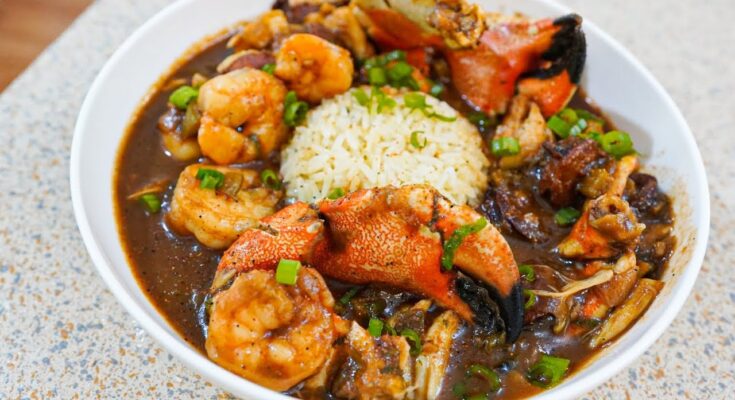Seafood Gumbo Recipe: Seafood gumbo is a classic dish rooted in Southern Louisiana cuisine. It’s a flavorful, hearty stew packed with shrimp, crab, and sometimes oysters, mixed with a medley of vegetables and rich spices. The combination of Cajun and Creole flavors creates a perfect harmony of taste and tradition.
This dish is more than just a meal—it’s an experience. The preparation may seem intricate, but once you get the hang of it, making gumbo can become a cherished tradition in your home. Whether you’re hosting a family gathering or celebrating a special occasion, seafood gumbo never fails to impress.
In this guide, we’ll walk you through each step, ensuring you achieve a perfect gumbo loaded with flavor and authenticity. Let’s dive in!
Ingredients Needed
Seafood Selection:
- Shrimp (peeled and deveined): 1 pound
- Crab meat (lump or claw): 1 pound
- Oysters (optional): 1 cup
- Crawfish tails (optional): ½ pound
Vegetables and Seasonings:
- Onion (diced): 1 large
- Celery (chopped): 1 cup
- Bell peppers (green and red): 1 cup, diced
- Garlic (minced): 4 cloves
- Green onions (chopped): ½ cup
- Parsley (chopped): ¼ cup
Essential Spices and Herbs:
- Cajun seasoning: 2 tablespoons
- Paprika: 1 tablespoon
- Thyme (dried): 1 teaspoon
- Bay leaves: 2
- Salt and pepper to taste
Other Essentials:
- Chicken or seafood broth: 6 cups
- Vegetable oil or butter: 1 cup
- Flour (for roux): 1 cup
- Okra (sliced): 2 cups (optional for thickening)
- Filé powder: 1 teaspoon (optional for flavor and thickening)
- Cooked white rice (for serving): 4 cups
Preparation Before Cooking
Cleaning and Preparing Seafood:
- Shrimp: Rinse thoroughly, remove shells and tails, and devein them.
- Crab Meat: Check for any leftover shells and separate chunks if needed.
- Oysters and Crawfish: Rinse well to remove grit and pat dry.
Chopping Vegetables:
- Dice the onions, celery, and bell peppers uniformly to ensure even cooking.
- Mince the garlic finely for maximum flavor release.
- Chop parsley and green onions for garnishing at the end.
Organizing Ingredients:
- Measure and set aside spices, herbs, and seasonings.
- Pre-mix the broth and keep it warm for easy blending later.
- Place all ingredients within reach to streamline cooking.
Proper preparation reduces stress and ensures smooth execution once you start cooking!
Making the Roux – The Heart of Gumbo
What is Roux?
Roux is a mixture of fat (butter or oil) and flour, cooked slowly until it turns brown. It acts as the thickening base for the gumbo and adds a nutty flavor. Achieving the perfect roux is crucial—it sets the tone for your entire dish.
Steps to Make a Perfect Roux:
- Heat Oil or Butter: Use a large, heavy-bottomed pot or Dutch oven over medium heat.
- Add Flour Gradually: Stir continuously with a wooden spoon or whisk to prevent lumps.
- Cook Until Desired Color: Roux color ranges from blonde to dark brown. For seafood gumbo, a medium to dark brown roux works best.
- Keep Stirring: Stirring nonstop avoids burning, which can ruin the flavor. The process can take 15–20 minutes, so patience is key.
Pro Tip: If you see black specks, the roux is burnt. It’s better to start over than risk ruining the gumbo.
Cooking the Base for Seafood Gumbo
Sautéing Vegetables:
- Add chopped onions, celery, and bell peppers (the “holy trinity”) to the roux.
- Stir and cook until the vegetables soften—about 5 minutes.
- Add garlic and cook for another 1–2 minutes until fragrant.
Combining Broth and Roux:
- Gradually pour in the broth, stirring constantly to prevent lumps.
- Add bay leaves, thyme, and paprika.
- Simmer for 15–20 minutes, allowing flavors to meld.
Optional Step: If using okra, add it now and let it cook until tender, which also helps thicken the gumbo.
Adding Seafood and Other Ingredients
Now comes the exciting part—adding the seafood and other essential ingredients to bring the gumbo to life!
Step 1: Layering in the Seafood
- Add Shrimp: Drop the peeled and deveined shrimp into the simmering gumbo base. Stir gently to prevent breaking them apart.
- Add Crab Meat: Carefully mix in the lump or claw crab meat. If using whole crab legs, place them in the pot to cook slowly and infuse their rich flavor into the broth.
- Add Oysters and Crawfish (Optional): For a bolder seafood flavor, include oysters and crawfish tails. Make sure they’re added in the last 10–15 minutes of cooking to avoid overcooking.
Step 2: Simmer and Blend Flavors
- Lower the heat and let the gumbo simmer for 20–25 minutes. Stir occasionally to ensure nothing sticks to the bottom.
- Taste and adjust seasoning—add more Cajun spices, salt, or pepper if necessary.
Step 3: Incorporate Filé Powder (Optional)
- Filé powder, made from dried sassafras leaves, is often used to enhance flavor and add thickness. Stir in 1 teaspoon just before serving for an earthy, aromatic finish.
- Be careful—filé powder can become stringy if boiled, so it’s best added at the end.
Simmering the Gumbo – Achieving Perfect Flavor
Ideal Simmering Time
Seafood gumbo thrives on slow cooking. Simmer it for at least 45 minutes to 1 hour to allow all the flavors to meld perfectly. However, if you’re short on time, a minimum of 30 minutes is required.
Taste Testing and Adjustments
- Salt and Spice Levels: Add small amounts of seasoning and taste frequently to prevent over-seasoning.
- Consistency Check: If it’s too thin, you can thicken it by adding more okra or a cornstarch slurry (1 tablespoon cornstarch mixed with 2 tablespoons water).
Thickening the Gumbo – Final Touch
Gumbo is known for its slightly thick and hearty texture. Here’s how to achieve that perfect consistency:
- Okra Method: Okra naturally thickens gumbo as it cooks. If using frozen okra, thaw and drain it before adding.
- Roux Method: Since the roux already serves as a thickener, ensure it’s rich and dark before adding it to the broth.
- Filé Powder: Sprinkle it at the end of cooking, but don’t let it boil.
Pro Tip: Let the gumbo sit for about 10 minutes after cooking to allow the flavors to settle and thicken naturally.
Serving Suggestions
Seafood gumbo is best enjoyed hot and fresh. Here are some serving ideas:
With Rice:
- Spoon the gumbo over steamed white rice or brown rice for a complete meal.
Bread Pairings:
- Serve with French bread or cornbread to soak up the flavorful broth.
Garnishing Tips:
- Sprinkle chopped green onions and fresh parsley on top for added color and freshness.
- Add a dash of hot sauce for extra heat.
Presentation for Guests:
- Serve gumbo in large bowls with crab legs sticking out for visual appeal, especially during holidays or special gatherings.
Variations of Seafood Gumbo
Gumbo is versatile, allowing for different styles and ingredients.
Cajun vs. Creole Gumbo:
- Cajun Gumbo: Uses a dark roux and often lacks tomatoes. It focuses more on rich, smoky flavors.
- Creole Gumbo: Incorporates tomatoes and is slightly lighter, with more emphasis on herbs and aromatics.
Vegetarian and Vegan Options:
- Replace seafood with mushrooms, okra, and tofu for a plant-based version.
- Use vegetable broth instead of chicken or seafood broth.
Protein Substitutes:
- Add chicken and sausage if you prefer a non-seafood gumbo variation.
Nutritional Information
Seafood gumbo is not only flavorful but also provides a range of nutrients:
| Nutrient | Per Serving (1 Cup) |
|---|---|
| Calories | 250–300 kcal |
| Protein | 20–25 g |
| Carbohydrates | 18–22 g |
| Fat | 10–12 g |
| Fiber | 3–5 g |
| Sodium | 800–1000 mg |
Health Benefits of Ingredients:
- Shrimp and Crab: Rich in protein and omega-3 fatty acids for heart health.
- Okra: Packed with fiber, vitamins, and antioxidants.
- Garlic and Onions: Known for their anti-inflammatory and immune-boosting properties.
Common Mistakes to Avoid
- Burning the Roux: Stir continuously and cook over low heat to prevent burning.
- Overcooking Seafood: Add seafood towards the end to avoid rubbery textures.
- Skipping Seasoning Adjustments: Taste as you go and make gradual adjustments.
- Rushing the Simmering Process: Let the gumbo cook slowly for richer flavor development.
Storage and Reheating Tips
Storing Leftovers:
- Allow the gumbo to cool completely before transferring it to an airtight container.
- Store in the refrigerator for up to 3 days or freeze for 2–3 months.
Reheating Without Losing Flavor:
- Reheat on low heat, stirring frequently. Add a splash of water or broth if it thickens too much.
Seafood Gumbo for Special Occasions
Seafood gumbo isn’t just a dish—it’s a showstopper for celebrations, holidays, and family gatherings. With its rich flavors and hearty ingredients, it naturally fits into festive occasions.
Holiday Presentation Ideas
- Seafood Extravaganza: Include crab legs and whole shrimp in the shells for a dramatic presentation. Serve it in a large Dutch oven or decorative soup tureen.
- Serving Stations: Set up a self-serve gumbo bar with bowls of rice, chopped parsley, green onions, hot sauces, and crusty bread. Let guests customize their portions.
- Garnish with Style: Top each serving with a crab claw or a sprinkle of filé powder for a professional touch.
Serving a Large Crowd
If hosting a big event, double or triple the recipe. Seafood gumbo scales well, but remember to adjust cooking times slightly for larger batches.
Pro Tip: Make the gumbo base a day in advance, allowing the flavors to deepen overnight. Add the seafood just before serving to keep it tender and fresh.
FAQs about Seafood Gumbo Recipe
What type of seafood should I use in gumbo?
For an authentic seafood gumbo, a combination of shrimp, crab, and oysters is ideal. Ensure the seafood is fresh or high-quality frozen to enhance the flavor of your gumbo.
How do I thicken seafood gumbo?
The traditional thickener for gumbo is a roux, which is flour cooked with fat (like oil or butter) until it reaches a dark brown color. Alternatively, you can use okra or file powder (ground sassafras leaves) as thickeners.
Can I make seafood gumbo in advance?
Yes, gumbo tastes even better the next day as the flavors have more time to meld. Prepare it a day ahead, cool, and refrigerate. Reheat gently before serving.
Is seafood gumbo gluten-free?
Traditional gumbo uses a flour-based roux, but you can make it gluten-free by using a gluten-free flour blend or skipping the roux and using cornstarch as a thickener instead.
What is the best way to serve seafood gumbo?
Serve seafood gumbo hot, typically over a bed of cooked white rice. Garnish with chopped green onions or parsley for extra flavor and a touch of color.
Conclusion
Seafood gumbo is more than just a meal—it’s a tradition, a celebration, and a comforting dish that brings people together. From its rich roux to the bold Cajun and Creole spices, every spoonful tells a story of culture and flavor.
Whether you’re making it for a Sunday dinner or a festive holiday feast, this step-by-step guide ensures your gumbo turns out perfect every time. With the right balance of seafood, seasonings, and thickening agents, you’ll create a dish that’s as satisfying as it is memorable.
Don’t be afraid to experiment with variations, and remember—practice makes perfect when it comes to gumbo. So, gather your ingredients, take your time with the roux, and enjoy the process of crafting this iconic Southern dish!



